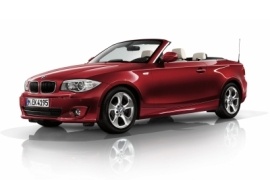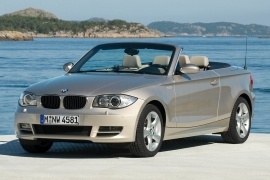BMW 1 Series Cabriolet Models/Series Timeline, Specifications & Photos
First production year: 2008
Engines: Diesel, Gasoline
Body style: Convertible (spider/spyder, cabrio/cabriolet, drop/open/soft top)
In 2010, despite the world financial crisis that drained automaker’s pockets, BMW decided to introduce a final upgrade for the 1 Series Convertible for the 2012 model year.
The 1 Series appeared in 2004 as a youth-oriented and more affordable alternative to the 3 Series. At first, the car was available exclusively as a five-door hatchback. Then, in 2007, along with the facelift for the model, BMW introduced other bodywork versions, such as the three-door hatchback, the coupe, and the convertible. The latter two came late to the 1 Series party, so the automaker considered that they were eligible for a facelift, which it did in 2010. Besides some aesthetical and functional tweaks to the bodywork, the car’s underpinning underwent mild changes. Unfortunately, sales didn’t go as planned. Still, the German brand didn’t back up and kept both versions on the market until they were replaced by the following generation of the 1 Series in 2013.
BMW made some of the most significant exterior changes to the car’s front. Depending on the version, the 2012 BMW 1 Series Convertible came with a fresh seat of headlights that sported Adaptive Xenon headlamps with cornering function. Furthermore, it integrated LED lights, emphasizing the car’s sporty character. In addition, to enhance the vehicle’s aerodynamics and lower the drag coefficient, BMW installed a redesigned bumper with a new apron. There, it put a reversed trapezoidal air intake flanked by a pair of functional scoops. These grabbed air and diverted it around the wheel arches, thus enhancing the airflow.
From its profile, the 2012 BMW 1 Series Convertible showed a sportier stance thanks to the lower front apron and the redesigned alloy wheels. But still, it kept the same overall shape as its predecessor from 2008. The same went with the power-retractable roof, which could be opened or closed remotely by keeping the open or close button pressed on the key fob. Furthermore, it could be deployed or retracted in 22 seconds at speeds of up to 25 mph (40 kph). A subtle yet important upgrade was for the taillights. These featured LEDs arranged in an L shape above the clear lenses for the reversing lights.
Inside, BMW introduced new upholstery that didn’t heat up as much as regular leather, which was a significant improvement for those who left their cars with the soft top down. In addition, since the automaker believed that the 1 Series Convertible was a true four-season vehicle, it added a Cold Weather pack that included a heated steering wheel. But despite its efforts, there was no way how to create more legroom for the rear-seated passengers.
Under its skin, the 2012 BMW 1 Series Convertible had one significant change for the engine compartment, where the automaker introduced a new straight-six turbocharged gasoline powerplant for the 135i version. Even though it didn’t bring any ponies to the table, it still provided a better power and torque curve. In addition, this version could be equipped with a seven-speed dual-clutch (DCT) gearbox, which shortened gear change times. Other significant improvements were made to the rear differential, which was electronically controlled.
BMW 1 Series Cabriolet (E88) 118i 6MT RWD (143 HP)
BMW 1 Series Cabriolet (E88) 120i 6MT RWD (170 HP)
BMW 1 Series Cabriolet (E88) 125i 6MT RWD (218 HP)
BMW 1 Series Cabriolet (E88) 128i 6AT RWD (230 HP)
BMW 1 Series Cabriolet (E88) 128i 6MT RWD (230 HP)
BMW 1 Series Cabriolet (E88) 135i 6AT RWD (306 HP)
BMW 1 Series Cabriolet (E88) 135i 6MT RWD (306 HP)
BMW 1 Series Cabriolet (E88) 135i 7AT RWD (306 HP)
BMW unveiled the open-top version of the 1 Series at the 2007 Frankfurt International Motor Show, a few months after the introduction of its two-door sibling.
After the German automaker introduced the facelifted version of the 1 Series at the 2007 Geneva Motor Show in March and also released the three-door hatchback version, customers were left wondering if that was the end. The answer was no, and the Coupe followed the same year. Then, finally, in September of the same year, the drop-top version was launched. It was based on the two-door coupe version, not on the hatchback, and charmed its customers with its street-oriented dimensions. Nevertheless, its punchy engines made the premium small-sized convertible filled with upscale amenities a desirable vehicle for those looking not for just another car in their parking lot but for a pleasant experience behind the wheel.
The 1 Series convertible shared its front fascia with the refreshed version of the 1 Series. Its large headlights resembled those from the 3 Series but were significantly different. The clear lens over the twin headlamps was extended on the outer side to cover the turn signal lamps as well. Between them, the automaker placed the restyled kidney grille that sported rounded upper outer corners and vertical slats, surrounded by a chromed rim. Lower, on the bumper, BMW installed a broad air intake flanked by horizontally split side scoops that housed rectangular fog lamps at their upper side and cooling ducts for the front rotors on the lower one.
From its profile, the 2008 BMW 1 Series Convertible continued the automaker’s idea to create a cabriolet without any pillars other than those that supported the windshield. As a result, behind the thick and raked A-pillars, nothing obstructed the car’s profile above the waistline. BMW used the same doors as those from the Coupe and the three-door hatchback, with their frameless window design. The removable B-posts were retracted along with the rear-side windows. BMW also tried to follow the same shape of the Coupe’s greenhouse when the rag-top was closed. To do that, the automaker created a designated compartment behind the rear bench seat. Out back, the drop-top version of the 1 Series featured a short deck with a trunk lid that integrated a tiny lip spoiler and a third braking lamp. It was flanked by corner-mounted taillights that sported wide reversing lights on their lower area, covered by clear lenses.
Inside, the dashboard and the materials used on the 2008 BMW 1 Series Convertible were on par with what the carmaker’s customers expected. The small instrument cluster that fronted the driver sported two large dials for the speedometer and tachometer and a small gauge for the fuel level. For everything else, the automaker installed warning lights and a small digital display that showed data from the onboard computer. At the front, the sport bucket seats with high-bolstered areas provided great side support for their occupants. At the same time, there was almost no legroom. But still, BMW installed it so customers could use it either as an additional storage area or in an emergency.
Since the convertible was heavier than any of its siblings, BMW didn’t install the lowest-powered engines from the 1 Series. Instead, it provided the car with a wide choice of powerplants ranging between 143 PS (141 hp) and 306 PS (302 hp) paired with either a six-speed manual or a six-speed automatic transmission.
BMW 1 Series Cabriolet (E88) 118i 6AT RWD (143 HP)
BMW 1 Series Cabriolet (E88) 118i 6MT RWD (143 HP)
BMW 1 Series Cabriolet (E88) 120i 6AT RWD (170 HP)
BMW 1 Series Cabriolet (E88) 120i 6MT RWD (170 HP)
BMW 1 Series Cabriolet (E88) 125i 6AT RWD (218 HP)
BMW 1 Series Cabriolet (E88) 125i 6MT RWD (218 HP)

